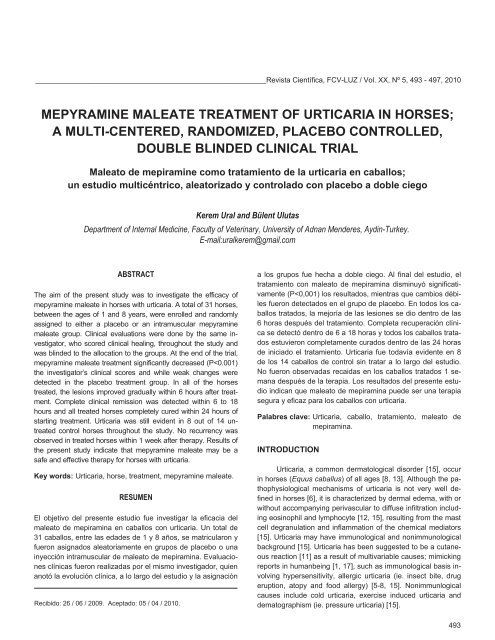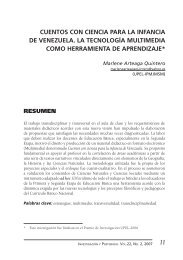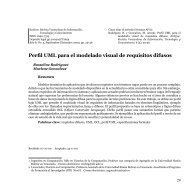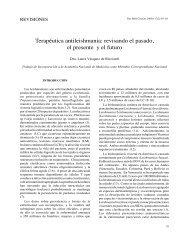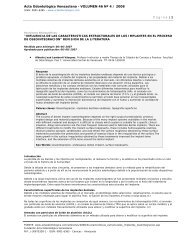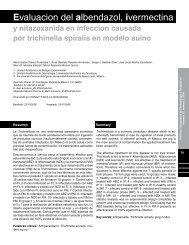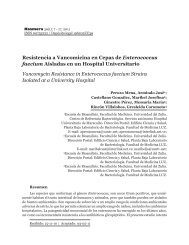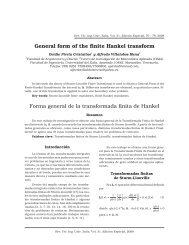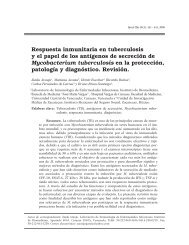mepyramine maleate treatment of urticaria in horses - Saber -ULA
mepyramine maleate treatment of urticaria in horses - Saber -ULA
mepyramine maleate treatment of urticaria in horses - Saber -ULA
Create successful ePaper yourself
Turn your PDF publications into a flip-book with our unique Google optimized e-Paper software.
_________________________________________________________Revista Científica, FCV-LUZ / Vol. XX, Nº 5, 493 - 497, 2010<br />
MEPYRAMINE MALEATE TREATMENT OF URTICARIA IN HORSES;<br />
A MULTI-CENTERED, RANDOMIZED, PLACEBO CONTROLLED,<br />
DOUBLE BLINDED CLINICAL TRIAL<br />
Maleato de mepiram<strong>in</strong>e como tratamiento de la <strong>urticaria</strong> en caballos;<br />
un estudio multicéntrico, aleatorizado y controlado con placebo a doble ciego<br />
Kerem Ural and Bülent Ulutas<br />
Department <strong>of</strong> Internal Medic<strong>in</strong>e, Faculty <strong>of</strong> Veter<strong>in</strong>ary, University <strong>of</strong> Adnan Menderes, Ayd<strong>in</strong>-Turkey.<br />
E-mail:uralkerem@gmail.com<br />
ABSTRACT<br />
The aim <strong>of</strong> the present study was to <strong>in</strong>vestigate the efficacy <strong>of</strong><br />
<strong>mepyram<strong>in</strong>e</strong> <strong>maleate</strong> <strong>in</strong> <strong>horses</strong> with <strong>urticaria</strong>. A total <strong>of</strong> 31 <strong>horses</strong>,<br />
between the ages <strong>of</strong> 1 and 8 years, were enrolled and randomly<br />
assigned to either a placebo or an <strong>in</strong>tramuscular <strong>mepyram<strong>in</strong>e</strong><br />
<strong>maleate</strong> group. Cl<strong>in</strong>ical evaluations were done by the same <strong>in</strong>vestigator,<br />
who scored cl<strong>in</strong>ical heal<strong>in</strong>g, throughout the study and<br />
was bl<strong>in</strong>ded to the allocation to the groups. At the end <strong>of</strong> the trial,<br />
<strong>mepyram<strong>in</strong>e</strong> <strong>maleate</strong> <strong>treatment</strong> significantly decreased (P
Mepyram<strong>in</strong>e Maleate Treatment <strong>of</strong> Urticaria <strong>in</strong> Horses / Ural, Kerem and Ulutas, Bülent _________________________________________<br />
Cl<strong>in</strong>ical appearance <strong>of</strong> equ<strong>in</strong>e <strong>urticaria</strong> presents as<br />
wheals, with acute to peracute onset, develop<strong>in</strong>g with<strong>in</strong> m<strong>in</strong>utes<br />
to hours [15], distributed bilateral and symmetrical on the<br />
trunk, neck, thorax, abdomen and extremities [8, 15]. Other<br />
rare cl<strong>in</strong>ical signs <strong>in</strong>volve papule, giant (up to 20-40 cm diametered)<br />
or exudative wheals and gyrate/polycyclic forms [8, 15].<br />
Cl<strong>in</strong>ical management <strong>of</strong> <strong>urticaria</strong> <strong>in</strong>volves food elim<strong>in</strong>ation,<br />
<strong>in</strong>tradermal sk<strong>in</strong> test<strong>in</strong>g and if necessary, subsequent hyposensitization<br />
therapy, and adm<strong>in</strong>istration <strong>of</strong> corticosteroids<br />
and antihistam<strong>in</strong>es. Another important po<strong>in</strong>t <strong>of</strong> cl<strong>in</strong>ical management<br />
is environmental modifications, for example, mov<strong>in</strong>g the<br />
horse to another location, elim<strong>in</strong>at<strong>in</strong>g sources <strong>of</strong> molds, remov<strong>in</strong>g<br />
stagnant water and stabl<strong>in</strong>g the horse <strong>in</strong> times when <strong>in</strong>sects<br />
are known to be feed<strong>in</strong>g. To the present author’s knowledge,<br />
<strong>in</strong>tradermal test<strong>in</strong>g has not been commonly used <strong>in</strong><br />
equ<strong>in</strong>e practice <strong>in</strong> Turkey. Corticosteroid <strong>treatment</strong> (i.e. prednisolone<br />
and dexamethasone) is commonly effective for controll<strong>in</strong>g<br />
<strong>urticaria</strong> occur<strong>in</strong>g as a result <strong>of</strong> atopy, <strong>in</strong>deed they may<br />
cause serious side effects such as lam<strong>in</strong>itis, steroid <strong>in</strong>duced<br />
hepatopathy and iatrogenic hyperadrenocorticism [4, 14].<br />
Antihistam<strong>in</strong>es such as hydroxiz<strong>in</strong>e pamoate and doxep<strong>in</strong><br />
hydrochloride may be used <strong>in</strong> <strong>horses</strong> with <strong>urticaria</strong> [16]. However<br />
hydroxiz<strong>in</strong>e and doxep<strong>in</strong>, may both cause side effects as drows<strong>in</strong>ess<br />
and nervousness <strong>in</strong> <strong>horses</strong> [16], result<strong>in</strong>g with challeng<strong>in</strong>g<br />
owner compliance. Therefore, a safely used and reasonably<br />
priced antihistam<strong>in</strong>e that could be used for releiv<strong>in</strong>g <strong>urticaria</strong><br />
would be <strong>of</strong> significant benefit to <strong>in</strong>crease owner compliance.<br />
The first-generation antihistam<strong>in</strong>es are commonly prescribed<br />
drugs reliev<strong>in</strong>g allergic reactions and <strong>urticaria</strong>. Mepyram<strong>in</strong>e<br />
is a first generation antihistam<strong>in</strong>e, block<strong>in</strong>g the peripheral<br />
histam<strong>in</strong>e H(1) receptor [9]. It has been reported to cure photosensitization<br />
<strong>in</strong> lambs (Ovis aries) [12], acute respiratory distress<br />
<strong>in</strong> cows (Bos taurus) [3] and to prevent nausea and vomitt<strong>in</strong>g <strong>in</strong>duced<br />
by xylaz<strong>in</strong>e <strong>in</strong> dogs (Canis lupus familiaris) [2]. It is commercially<br />
available <strong>in</strong> Turkey <strong>in</strong> the veter<strong>in</strong>ary market. The purpose<br />
<strong>of</strong> this study was to evaluate the efficacy <strong>of</strong> <strong>mepyram<strong>in</strong>e</strong><br />
<strong>maleate</strong> for the <strong>treatment</strong> <strong>of</strong> equ<strong>in</strong>e <strong>urticaria</strong> <strong>in</strong> a multi-centered,<br />
randomized, placebo controlled, double bl<strong>in</strong>ded cl<strong>in</strong>ical trial.<br />
MATERIAL AND METHODS<br />
Study design<br />
Multicentered, randomized, placebo-controlled, doublebl<strong>in</strong>ded<br />
cl<strong>in</strong>ical trial.<br />
Animals<br />
A total <strong>of</strong> 31 <strong>horses</strong> with history <strong>of</strong> conventional <strong>urticaria</strong><br />
conf<strong>in</strong>ed to different body parts were enrolled <strong>in</strong> the present<br />
study. The <strong>horses</strong> ranged <strong>in</strong> age from 1 to 11 years. There<br />
were 17 mares, 8 stallions and 6 geld<strong>in</strong>gs. Breeds represented<br />
* Histavet <strong>in</strong>j. flk., Vetas®, Turkey.<br />
<strong>in</strong>cluded: 6 Thoroughbred, 5 Arabian, 5 Akhal Teke, 4 Dutch<br />
Warmblood, 4 Ponies, 3 Holste<strong>in</strong>er and 1 <strong>of</strong> each <strong>of</strong> the follow<strong>in</strong>g<br />
breeds: Selle Francais, Belgian Warmblood, Fresien and<br />
unknown breed.<br />
Allocation to <strong>treatment</strong> and owners’ evaluation<br />
Horses were randomized by co<strong>in</strong> toss, <strong>in</strong> that the side <strong>of</strong><br />
the co<strong>in</strong> (heads=control, tails= <strong>treatment</strong>) determ<strong>in</strong>ed the assignment<br />
<strong>of</strong> each horse. Once enrolled, <strong>horses</strong> were randomly<br />
allocated <strong>in</strong>to two groups. Both owners and the <strong>in</strong>vestigator<br />
were bl<strong>in</strong>ded regard<strong>in</strong>g the allocation to groups. One group,<br />
consist<strong>in</strong>g <strong>of</strong> 17 <strong>horses</strong>, received <strong>in</strong>tramuscular <strong>mepyram<strong>in</strong>e</strong><br />
<strong>maleate</strong>* adm<strong>in</strong>istration at a dosage <strong>of</strong> 2mg/kg twice at 12 hours<br />
<strong>in</strong>tervals, while the other group, consist<strong>in</strong>g 14 <strong>horses</strong>, received<br />
the placebo conta<strong>in</strong><strong>in</strong>g purified water (at equivalent doses <strong>of</strong><br />
<strong>mepyram<strong>in</strong>e</strong> <strong>maleate</strong>).<br />
Investigator’s evaluation <strong>of</strong> cl<strong>in</strong>ical lesions<br />
At the beg<strong>in</strong>n<strong>in</strong>g and at the end <strong>of</strong> the trial (hours 0, 6, 12,<br />
18 and 24) cl<strong>in</strong>ical lesions were scored by the same <strong>in</strong>vestigator<br />
us<strong>in</strong>g a scale from 0 to 3 (0 be<strong>in</strong>g absent, 3 be<strong>in</strong>g severe) (TA-<br />
BLE I). The used scor<strong>in</strong>g system was consistently applied to all<br />
the test subjects. Cl<strong>in</strong>ical lesions subject to evaluation <strong>in</strong>cluded<br />
alopecia, scal<strong>in</strong>g and crust<strong>in</strong>g. Areas Evaluated <strong>in</strong>cluded head,<br />
neck, shoulder, thorax, ventral abdomen and/or whole body.<br />
The total score <strong>of</strong> each horse was the sum <strong>of</strong> the scores assigned<br />
to each cl<strong>in</strong>ical signs. Therefore the total score for each<br />
horse was derived from the sum <strong>of</strong> the scores <strong>of</strong> alopecia,<br />
scal<strong>in</strong>g and crust<strong>in</strong>g and each horse was assessed on the<br />
same lesion on every exam<strong>in</strong>ation. Briefly the scores were averaged<br />
for each horse [i.e. if a horse had 2 areas evaluated on<br />
the nearside and only 1 on the <strong>of</strong>f side, these were added and<br />
divided by 3 (2+1)] to give the horse its score for that days exam<strong>in</strong>ation.<br />
Mean and standard deviations <strong>of</strong> score lesions regard<strong>in</strong>g<br />
the <strong>mepyram<strong>in</strong>e</strong> <strong>maleate</strong> group and the placebo was<br />
shown (FIG. 1). The lesion scor<strong>in</strong>g was carried out by an <strong>in</strong>vestigator<br />
bl<strong>in</strong>ded to the <strong>treatment</strong> the <strong>horses</strong> had received.<br />
The signs <strong>of</strong> resolution and therefore the improvement <strong>in</strong> cl<strong>in</strong>ical<br />
signs associated with <strong>urticaria</strong> were scored by the same <strong>in</strong>vestigator.<br />
In addition througout the study, all <strong>horses</strong> were<br />
checked daily for evidence <strong>of</strong> adverse reactions to <strong>treatment</strong>.<br />
Besides cl<strong>in</strong>ical follow-up was further carried out for 1 months<br />
for evaluation <strong>of</strong> possible recurrence.<br />
Cl<strong>in</strong>ical recovery was deemed the resolution <strong>of</strong> dermatologic<br />
changes related to <strong>urticaria</strong>. Cure was def<strong>in</strong>ed when all<br />
cl<strong>in</strong>ico-dermatological lesions were resolved.<br />
Statistical analysis<br />
Differences <strong>in</strong> the cl<strong>in</strong>ical score between the <strong>treatment</strong><br />
group and the untreated placebo control group on the exam<strong>in</strong>ation<br />
days were assessed by Mann-Whitney U test. Differences<br />
<strong>in</strong> the cl<strong>in</strong>ical score changes with<strong>in</strong>-subject factor <strong>of</strong> time<br />
were analyzed us<strong>in</strong>g Wilcoxon test [10].<br />
494
_______________________________________________________________Revista Científica, FCV-LUZ / Vol. XX, Nº 5, 493 - 497, 2010<br />
TABLE I<br />
ON HOURS 0, 6, 12 AND 24 HORSES WERE GIVEN A CLINICAL SCORE AND THE SEVERITY OF URTICARIA WAS GRADED<br />
AS: OF (ABSENT =0, MILD = 1, MODERATE = 2, SEVERE = 3) ACCORDING TO THE SEVERITY TYPES. THE SIGNS OF<br />
RESOLUTION AND THEREFORE THE DISAPPEARENCE OF URTICARIA WERE SCORED BY THE INVESTIGATOR BLINDED<br />
TO THE TREATMENT THE HORSES HAD RECEIVED. THE CASES WERE RANDOMLY ASSIGNED TO EITHER MEPYRAMINE<br />
MALEATE TREATMENT GROUP (N=17) OR A PLACEBO (N=14)./ EN LAS HORAS 0; 6; 12 Y 24 CABALLOS SE LES DIO UNA<br />
PUNTUACIÓN CLÍNICA Y LA SEVERIDAD DE LA URTICARIA SE CLASIFICA COMO: DE (AUSENTE = 0, LEVE = 1, MODERADA = 2, SEVERO = 3)<br />
SEGÚN EL TIPO DE GRAVEDAD. LOS SIGNOS DE LA RESOLUCIÓN Y POR LO TANTO LA DESAPARICIÓN DE LA URTICARIA FUERON ANOTADOS<br />
POR EL INVESTIGADOR CIEGO PARA EL TRATAMIENTO QUE LOS CABALLOS HABÍAN RECIBIDO. LOS CASOS FUERON ASIGNADOS AL AZAR A<br />
CUALQUIER GRUPO DE TRATAMIENTO CON MALEATO DE MEPIRAMINA (N = 17) O UN PLACEBO (N = 14).<br />
Hour_0 Hour_6 Day_12 Day_18 Hour_24<br />
Groups<br />
Score<br />
3 2 1 0 3 2 1 0 3 2 1 0 3 2 1 0 3 2 1 0<br />
Treatment (n=17) 11 3 3 0 4 3 3 7 1 2 4 10 0 1 1 15 0 0 0 17<br />
Placebo control (n=14) 9 2 3 0 7 3 3 1 5 3 3 3 6 2 2 4 4 2 2 6<br />
(TABLE II). They <strong>of</strong>ten exhibited conventional forms <strong>of</strong> <strong>urticaria</strong><br />
(24/31), and <strong>in</strong> addition giant/exudative (4/31) or polycyclic (gyrate)<br />
forms <strong>of</strong> wheals (3/31) (FIG. 2) were observed. Other less<br />
common signs <strong>in</strong>cluded scales (14/31), crusts (9/31), papules<br />
(8/31) (FIG. 4), alopecia (12/31) and ooz<strong>in</strong>g (4/31). The thorax<br />
(8/31), neck (7/31), and extremities (5/31) were most commonly<br />
<strong>in</strong>volved. All affected animals had normal temperature,<br />
pulse and respiration. Other body systems were also normal.<br />
FIGURA 1. INVESTIGATOR’S CLINICAL SCORES ON HOURS<br />
6, 12, 18 AND 24. SEVENTEEN HORSES WERE INCLUDED<br />
IN MEPYRAMINE MALEATE GROUP AND FOURTEEN IN<br />
PLACEBO GROUP. COMPARISON OF THE TWO GROUPS<br />
REVEALED THAT THE CLINICAL SCORES DID NOT DIFFER<br />
BETWEEN THE GROUPS ON HOUR 0, WHEREAS THE<br />
TREATMENT GROUP SHOWED A SIGNIFICANTLY LOWER<br />
CLINICAL SCORE THAN PLACEBO GROUP ON FROM<br />
HOUR 6 AND 12 (P
Mepyram<strong>in</strong>e Maleate Treatment <strong>of</strong> Urticaria <strong>in</strong> Horses / Ural, Kerem and Ulutas, Bülent _________________________________________<br />
TABLE II<br />
CLINICAL BACKGROUND FOR HORSES WITH URTICARIA. N, NUMBER OF HORSES WITH THE CLINICAL SIGNS<br />
COMPARED TO THE TOTAL NUMBER OF HORSES/LOS ANTECEDENTES CLÍNICOS PARA LOS CABALLOS CON URTICARIA.<br />
N, EL NÚMERO DE CABALLOS CON LOS SIGNOS CLÍNICOS EN COMPARACIÓN CON EL NÚMERO TOTAL DE CABALLOS.<br />
Sign N %<br />
Duration <strong>of</strong><br />
cl<strong>in</strong>ical signs<br />
N %<br />
Localization<br />
<strong>of</strong> lesions<br />
N %<br />
Wheals 31/31 100 < 1 week 11/31 35 Whole body 3/31 9<br />
-conventional 24/31 77 Head 3/31 9<br />
-giant/exudative 4/31 12 Neck 7/31 22<br />
-polycyclic (gyrate) 3/31 9 Shoulder 3/31 9<br />
Scales 14/31 45 >4 weeks 9/31 29 Extremities 5/31 16<br />
Crusts 9/31 29 recurr<strong>in</strong>g 4/31 12 Thorax 8/31 25<br />
Papules 8/31 25 >4 weeks 5/31 16 Abdomen 2/31 6<br />
Alopecia 12/31 38 >4 weeks 7/31 22<br />
Ooz<strong>in</strong>g 4/31 12 1-4 weeks 3/31 9<br />
FIGURE 2. URTICARIAL WHEALS LOCATED ON THE HEAD/<br />
RONCHAS DE URTICARIA SITUADAS EN LA CABEZA.<br />
FIGURE 4. MULTIPLE WHEALS LOCATED ESPECIALLY ON<br />
THE THORAX, BEFORE TREATMENT/ MÚLTIPLES PÁP<strong>ULA</strong>S<br />
ENCONTRADAS ESPECIALMENTE EN EL TÓRAX, ANTES DEL TRATA-<br />
MIENTO.<br />
FIGURE 3. SAME HORSE SHOWN IN FIG.2, 24 HOURS AF-<br />
TER INITIAL TREATMENT. NOTICE CLINICAL HEALING<br />
AND DISAPPERANCE OF WHEALS/ CABALLO EN LA MISMA<br />
SE MUESTRA EN LA FIGURA 2, 24 HORAS DESPUÉS DEL TRATA-<br />
MIENTO INICIAL. NOTIFICACIÓN DE LA CURACIÓN CLÍNICA Y DESA-<br />
PARICIÓN DE RONCHAS.<br />
FIGURE 5. SAME HORSE SHOWN IN FIG.4, AFTER INITIAL<br />
MEPYRAMINE MALEATE TREATMENT, URTICARIAL LE-<br />
SIONS WERE DISAPPEARED IN THE HORSE ABOVE/ CA-<br />
BALLO EN LA MISMA SE MUESTRA EN LA FIG. 4, DESPUÉS DEL<br />
TRATAMIENTO INICIAL CON MEPIRAMINA MALEATO, LESIONES DE<br />
URTICARIA FUERON DESAPARECIDAS EN EL CABALLO, ARRIBA.<br />
496
_______________________________________________________________Revista Científica, FCV-LUZ / Vol. XX, Nº 5, 493 - 497, 2010<br />
designed to show both extent and severity <strong>of</strong> the disease and<br />
to monitor therapy. Comparison <strong>of</strong> the two groups revealed<br />
that the cl<strong>in</strong>ical scores did not differ between the groups on<br />
hour 0, while the <strong>treatment</strong> group showed a significantly lower<br />
cl<strong>in</strong>ical score than placebo group on hours 6 and 12 (P


